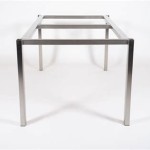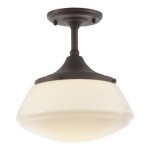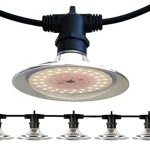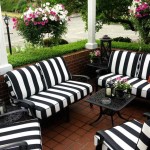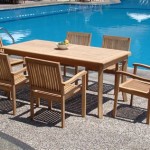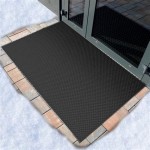Selecting the Perfect Dining Table and Chairs for Your Outdoor Space
The arrangement of an outdoor dining area significantly contributes to the enjoyment of patios, decks, and gardens. Choosing the right dining table and chairs is a crucial decision that involves considering various factors, including space constraints, aesthetic preferences, material durability, and budget. Careful planning ensures creating an inviting and functional outdoor space that enhances the overall outdoor living experience.
The selection process extends beyond mere aesthetics; it encompasses the practicality of using the furniture in all types of weather and the comfort it provides to users. Investing in furniture that withstands the elements and offers ergonomic support allows for hosting gatherings comfortably and ensures the longevity of the investment.
Considerations Based on Available Space
Prior to examining design options, assessing the available space is paramount. The size and layout of the patio, deck, or garden dictate the appropriate dimensions and configuration of the dining set. A small balcony necessitates a compact bistro set, while a large deck can accommodate a rectangular or oval table accompanied by several chairs.
Measuring the area accurately provides a tangible understanding of spatial constraints. It is also advisable to consider the traffic flow around the dining area. Ensuring adequate space for people to move around the table and chairs without feeling cramped adds to the overall usability of the space. This involves visualizing the arrangement with chairs pulled out and people seated.
Shape is another element related to space. Round tables are often favored in smaller areas as they promote conversation and take up less visual space. Rectangular tables, on the other hand, are well-suited for larger groups and elongated spaces. Square tables provide a balanced option between round and rectangular and work well in square-shaped areas.
In some cases, flexible furniture solutions, such as folding tables and stackable chairs, provide much-needed versatility. These can be easily stored when not needed, freeing up space for other activities. This is particularly useful for smaller outdoor spaces that serve multiple purposes.
Material Selection for Durability and Longevity
Outdoor furniture is constantly exposed to the elements, making material choice a vital decision. Each material possesses unique qualities in terms of weather resistance, maintenance requirements, and overall durability. Commonly used materials include wood, metal, plastic, and wicker, each with its advantages and disadvantages.
Wood, particularly teak, is a popular choice for outdoor furniture due to its natural resistance to decay, insects, and water damage. Teak's high oil content acts as a natural preservative, allowing furniture to withstand exposure to rain and sunlight. However, teak requires periodic oiling to maintain its rich color and prevent weathering. Other wood types, such as cedar and redwood, also offer decent weather resistance, but may require more frequent treatments.
Metal furniture, typically constructed from aluminum or wrought iron, is another viable option. Aluminum is lightweight, rust-resistant, and requires minimal maintenance. It’s a good choice for those who need to move their furniture around frequently. Wrought iron, on the other hand, is heavier and more durable but prone to rust if not properly treated. Protective coatings, such as powder coating, are essential for protecting wrought iron furniture from the elements.
Plastic furniture, often made from recycled materials, presents a cost-effective and low-maintenance option. It is resistant to water damage, fading, and cracking, making it an ideal choice for harsh weather conditions. However, plastic furniture may not offer the same level of aesthetic appeal or structural integrity as wood or metal.
Wicker furniture, traditionally made from natural materials like rattan or bamboo, offers a classic and elegant look. Contemporary wicker furniture often utilizes synthetic materials, such as resin wicker, which provides increased durability and weather resistance. Synthetic wicker is resistant to fading, cracking, and mildew, making it a practical choice for outdoor environments. However, wicker furniture may require more frequent cleaning to remove dirt and debris.
Style and Comfort Considerations
The style of the dining table and chairs should complement the overall aesthetic of the outdoor space. Whether opting for a modern, rustic, or traditional design, the furniture should integrate seamlessly with the existing landscaping, architecture, and decorative elements. Consistency in style enhances the visual appeal of the outdoor area and creates a cohesive environment.
Comfort is a non-negotiable factor. Dining chairs should provide adequate back support and comfortable seating. Features like armrests and cushions enhance the sitting experience. Cushions should be made from weather-resistant fabrics that can withstand exposure to sunlight and moisture. Quick-drying cushions are particularly beneficial in areas with frequent rainfall.
The table height should also be considered for optimal comfort. A standard dining table height typically ranges from 28 to 30 inches, providing sufficient legroom for most individuals. If choosing bar-height seating, ensure that the table is appropriately tall to accommodate the chairs comfortably.
Color also plays a significant role in the overall aesthetic. Neutral tones, such as beige, gray, and white, create a calming and sophisticated atmosphere. Bold colors can add visual interest and personality to the outdoor space. However, it is important to choose colors that complement the surrounding environment and avoid clashing with existing elements.
Beyond furniture, consider how to maximize comfort. Adding an outdoor rug can define the dining area and soften the hard surface of a patio or deck. Umbrellas or pergolas provide shade from the sun, allowing for comfortable outdoor dining even on hot days. Outdoor lighting sets the ambiance for evening gatherings and extends the usability of the space.
Maintenance and Care
Maintaining outdoor dining furniture is essential to extend its lifespan and keep it looking its best. The specific maintenance requirements vary depending on the materials used, but regular cleaning and protective measures are crucial.
Wooden furniture, especially teak, requires periodic cleaning and oiling. Cleaning removes dirt, debris, and mildew, while oiling helps to replenish the wood's natural oils and prevent weathering. It is recommended to clean wooden furniture at least twice a year and oil it as needed, depending on the level of exposure to the elements.
Metal furniture should be regularly inspected for signs of rust or corrosion. Aluminum furniture typically requires only occasional cleaning with soap and water. Wrought iron furniture, on the other hand, requires more frequent cleaning and protective coatings to prevent rust. Applying a rust-inhibiting primer and paint can significantly extend the lifespan of wrought iron furniture.
Plastic furniture is generally easy to clean with soap and water. However, it is important to avoid using harsh chemicals or abrasive cleaners, as they can damage the surface. Regular cleaning helps to prevent the buildup of dirt and grime and keeps the furniture looking its best.
Wicker furniture requires regular cleaning to remove dirt and debris. Synthetic wicker can be cleaned with soap and water, while natural wicker may require more specialized cleaning products. It is also important to protect wicker furniture from excessive moisture to prevent mildew and rot.
In addition to regular cleaning, storing outdoor furniture during the off-season can significantly extend its lifespan. Covering furniture with protective covers or storing it in a shed or garage helps to protect it from harsh weather conditions and prevent damage.
Cushions should be cleaned regularly to prevent the buildup of dirt and stains. Most outdoor cushions can be cleaned with soap and water. However, it is important to check the manufacturer's instructions for specific cleaning recommendations. Storing cushions indoors during inclement weather helps to prevent water damage and mildew.
Budget Considerations
Establishing a budget prior to shopping for outdoor dining furniture is essential for narrowing down the options and avoiding overspending. Prices for outdoor dining sets can vary widely depending on the materials, size, and style. It is important to consider the long-term value of the investment when making purchasing decisions.
While cost-effective options may be tempting, it is important to prioritize quality and durability. Investing in high-quality furniture that withstands the elements can ultimately save money in the long run by reducing the need for frequent replacements. Consider the lifespan of the furniture and the cost of maintenance when evaluating different options.
Shopping during off-season sales and clearance events can provide significant cost savings. Retailers often offer discounts on outdoor furniture at the end of the summer season to make room for new inventory. Taking advantage of these sales can help to stretch the budget and acquire high-quality furniture at a lower price.
Consider purchasing individual pieces rather than a complete dining set. This allows for greater flexibility in selecting furniture that aligns with specific needs and preferences. Mixing and matching different styles and materials can also create a unique and personalized outdoor dining area.
Exploring online retailers and consignment shops can also provide cost-effective options. Online retailers often offer a wider selection of furniture at competitive prices. Consignment shops may sell gently used outdoor furniture at a fraction of the original cost. However, it is important to carefully inspect used furniture for signs of damage or wear before making a purchase.
Consider the cost of accessories, such as cushions, umbrellas, and lighting, when establishing a budget. These accessories can significantly enhance the comfort and aesthetic of the outdoor dining area, but they can also add to the overall cost. Prioritize essential accessories and gradually add additional items as the budget allows.
Ultimately, selecting the perfect dining table and chairs for an outdoor space involves careful consideration of various factors. By assessing the available space, choosing durable materials, prioritizing comfort and style, and establishing a budget, it is possible to create an inviting and functional outdoor dining area that enhances the overall outdoor living experience. Thoughtful planning and informed decision-making ensure that the investment provides years of enjoyment and adds value to the home.

Elevate Your Dining Experience With Bahama Outdoor Set

Spydergreen Luxury Garden Patio Furniture Aluminum Rope Cafe Outdoor Dining Table Set Metal Chair Price In Buy

Upto 75 Off On Outdoor Dining Set Online Wooden Street

Alfresco Teak Wood Dining Table With 4 Chairs And Bench

Upto 75 Off On Outdoor Dining Set Online Wooden Street

Harrier Alu Garden Dining Table Set White Grey

Green Outdoor Dining Set

6 Piece Acacia Wood Outdoor Table And Chair Set Patio Furniture For Person Natural 4a Modernluxe

5 Piece Wicker Patio Dining Furniture Set With Seat Cushion Dark Brown And Green Table Without Glass Top

Buy Patio Dining Sets For Balcony Outdoor Garden Online Dreamlineoutdoorfurniture

